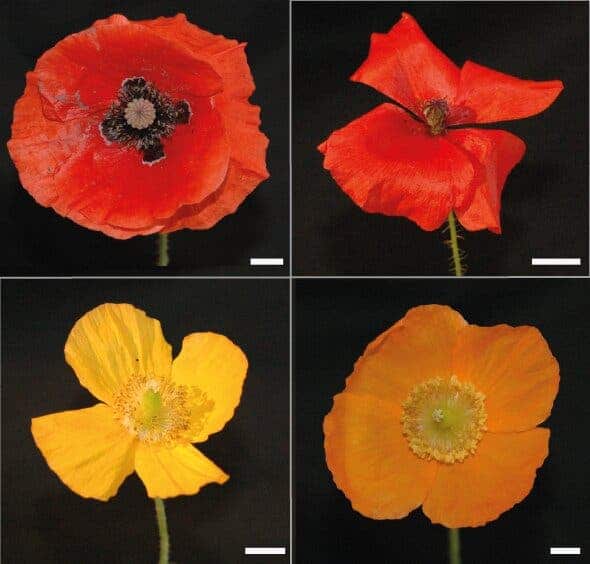A new study delves into how poppies create such vivid colors despite having very thin petals.

Image credits University of Groningen.
Poppy petals are ridiculously thin — they’re made up of only three layers of cells. To put that into perspective, your epidermis, which in itself is the thinnest layer of your skin, is made up of between 4 to 5 layers of cells. Yet, flake a bit of your epidermis off and you’ll see its translucent; light passes through it. A poppy’s petals, however, will shine with a fierce red (or shades of yellow, or even white, depending on the breed).
Pop-y red
In a bid to understand the flower’s impressive chromatic abilities, University of Groningen scientists Casper van der Kooi and Doekele Stavenga used microscopy and mathematical models of light behavior to see how these colors are created. The results will be included in a special edition of the Journal of Comparative Physiology A, which focuses on the relationship between insects and flowers.
The team collected petals from different poppies (Papaver, Meconopsis and related species) and looked at their microscopic structure. They report that, despite being very thin, the petals aren’t even saturated in pigment — the ‘color’ itself is only found in the outer cell layers, being completely absent in the middle one. The pigment is, however, very dense. Those dark markings in the middle don’t contain black pigment, but red ones in concentrations so extreme we perceive it as black. Van der Kooi, whose research focuses on the evolution of flower color and the interactions between flower color and pollinators, says that poppy has some of the “highest [pigment] concentrations that I have ever measured in any flower.”
Furthermore, pigment cells have an unusual shape. They look like jigsaw puzzle pieces that don’t really fit but just kind of stack together with some overlapping areas.
“This creates many air-filled gaps between the cells, which cause the reflection of light on the cell/air boundary,” Van der Kooi says, explaining that this causes “a very high scattering of light.”
Dense pigmentation, together with strong scattering, generates the striking red colors on certain parts of the poppy.
The study also ties into older research on color evolution in the poppy flower. It has previously been found that poppies in the Middle East don’t reflect ultraviolet (UV) light. Some European species — while seemingly identical to their Middle Eastern counterparts — do reflect UV light. Van der Kooi says this likely comes down to differences in main pollinators between the two areas. Poppies in the Middle East are pollinated primarily by beetles, whose eyes are rather good at picking up the color red.
“In Europe, poppies are pollinated mostly by bees, which cannot see red very well,” he explains. “However, they will pick up ultraviolet.”
“Moreover, previous studies have shown that the black spots at the heart of some poppies mimic the presence of a female beetle. This is a way for the flowers to attract male beetles. A case of sexual mimicry, as occurs in other plants such as orchids.”
Van der Kooi wants to continue his research and understand how the pigment cells and their efficient scattering evolved. He says that such “cell shapes are commonly present in leaves,” so he’ll likely start from there. Furthermore, the results suggest that poppies evolved to reflect UV light when they began growing in more northern regions, a hypothesis which he also plans to continue researching.
The paper “Vividly coloured poppy flowers due to dense pigmentation and strong scattering in thin petals” has been published in the Journal of Comparative Physiology A.



